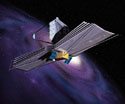|
 |
 |
|
| James Webb Space Telescope, Successor to Hubble |
|
 |
| This major facility-class space observatory will be launched in
2011 and is a successor to the very successful 2.5-m Hubble Space Telescope. While Hubble makes observations mainly in the visible and ultraviolet wavebands, the JWST mission concept is for a large filled-aperture telescope (primary mirror diameter of approximately 6.5 m) located far from Earth at the L2
Lagrangian point, about 1.5 million kilometres from the Earth. |
 (Image: NASA)
(Image: NASA) |
Shielded from the Sun and Earth by a large deployable sun-shade, the entire telescope assembly will be passively cooled to about 35K (35 degrees above absolute zero), giving JWST exceptional performance in the near-infrared and mid-infrared wavebands. The baseline wavelength range for the instrumentation is 0.6 to 28 microns, and the telescope will be diffraction-limited above
2 microns. The sensitivity of the telescope will be limited only by the natural zodiacal background, and should exceed that of ground-based and other space-based observatories by factors of 10 to 100,000, depending on the wavelength and type of observation. The JWST observatory will have a 5-
to 10-year lifetime and will not be serviceable by astronauts (as
is Hubble).
Like Hubble, the JWST will be used by a broad astronomical community to observe targets ranging from objects within our Solar System to the most remote galaxies seen during their formation in the early
universe. The science mission of JWST is centered on the quest to understand our
origins, and specifically aimed at:
- observing the very first generation of stars to illuminate the dark
universe when it was less than a billion years old. This major event in the history of the
universe likely occurred at red shifts of between 5 and 40.
- understanding the physical processes that have controlled the evolution of galaxies over cosmic time, and, in particular, identifying the processes that led to the assembly of galaxies within the first 4 billion years after the
Big Bang.
- tracking the chemical evolution of the universe whereby gas is enriched through the production and release by supernovae of the heavy elements, out of which planets and, ultimately, ourselves
were formed
- understanding the physical processes that control the formation and early evolution of stars in our own and other nearby
galaxies
- studying the formation and early evolution of proto-planetary disks, and characterizing the atmospheres of isolated planetary mass
objects
For various astrophysical reasons, all of these fundamental questions are best addressed in the near- and mid-infrared wavebands.
For more information, see the "Layperson's Guide to the NGST," by Simon Lilly (formerly
of the University of Toronto).
Canada has agreed to provide two major hardware contributions to
JWST. These are the fine guidance sensor (FGS), and a major participation in the
near infra-red camera (NIRCAM). In addition, Canada will provide a science team member in the
ESA-supported NIRSPEC.
The FGS is integral to the attitude control system of JWST, and consists of two fully redundant instruments that will enable precise (3 milli-arcseconds) pointing of the telescope. Canadian expertise in this area has already been demonstrated with the highly successful fine
error sensors for the FUSE mission.
The near
infra-red camera (NIRCam) will cover a field of some
five arcminutes in four different wavelength bands within range
one to five microns. Canada is to provide the moving filter wheels and a set of unique tunable filters for the NIRCAM. Selected by a NASA Announcement of Opportunity, the NIRCAM team has two industrial partners and four scientists from Canada.
The Canadian Project Scientist for NGST is Dr. John Hutchings of the Herzberg Institute of Astrophysics, National Research Council of Canada.
Animation:

(Image: ESA) |
|
|